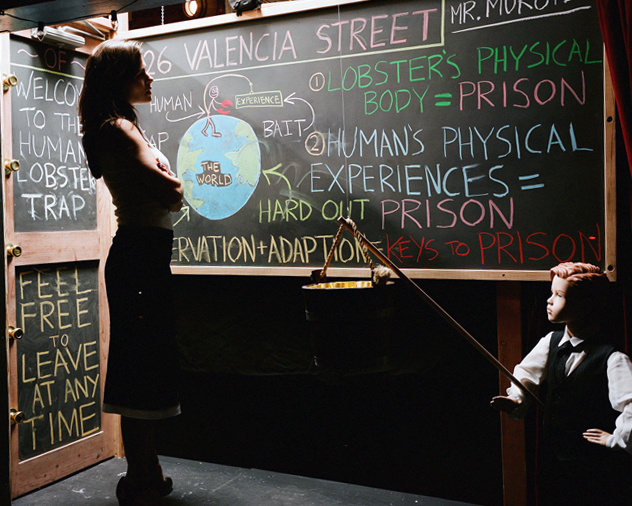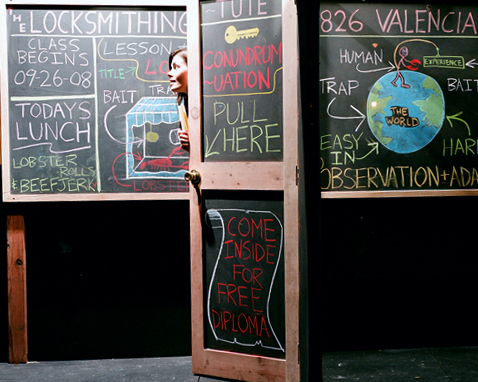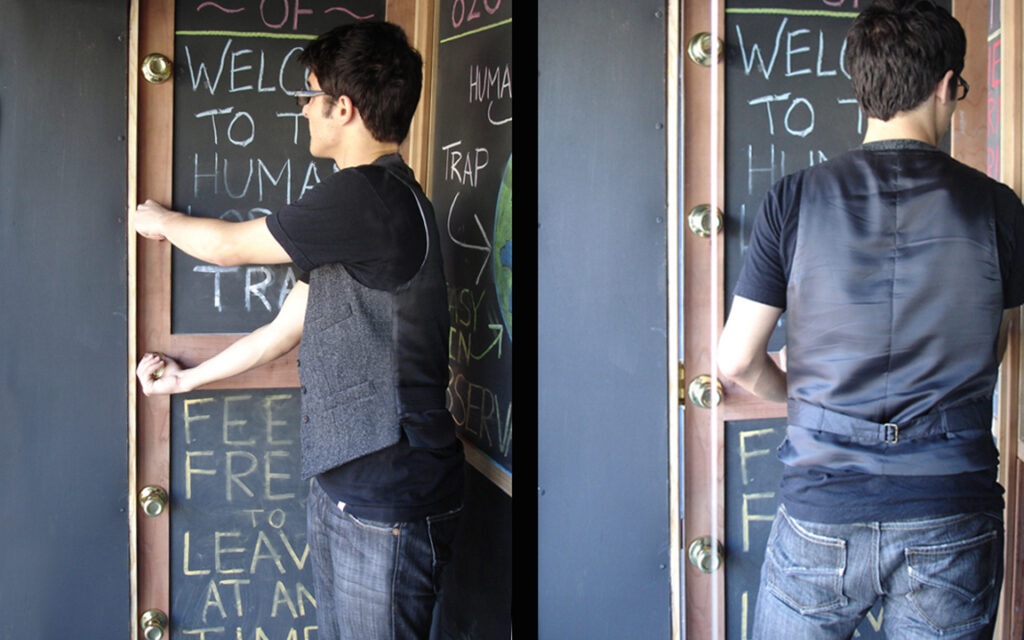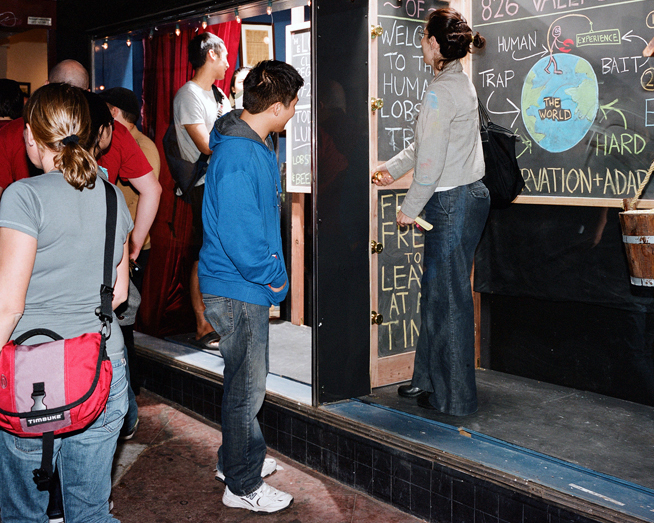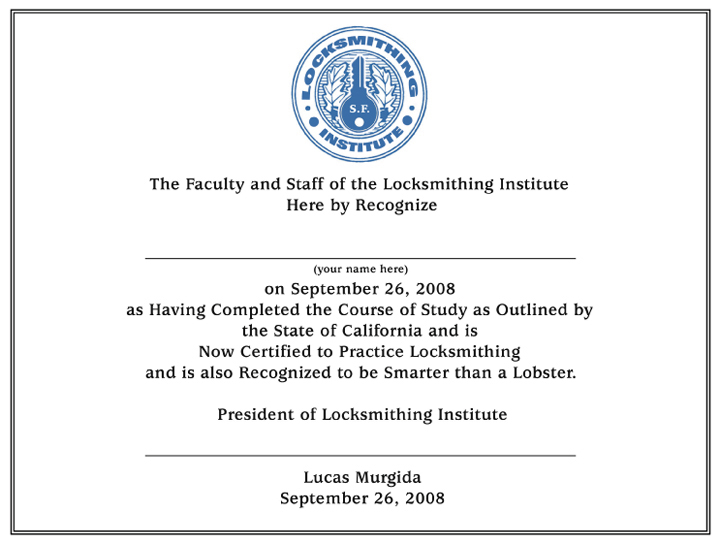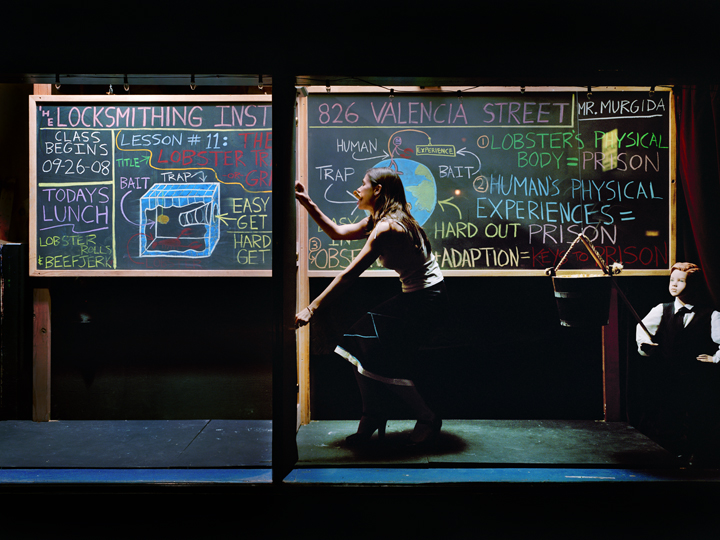
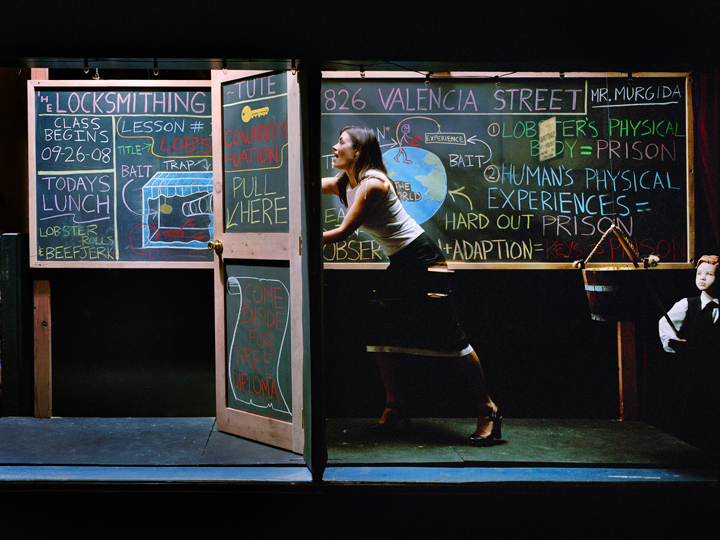 Above: In 2010, these two photographs were purchased by the Berkeley Art Museum for their permanent collection.
Above: In 2010, these two photographs were purchased by the Berkeley Art Museum for their permanent collection.
The Locksmithing Institute of 826 Valencia Street, San Francisco, CA, September, 2008
For the final lesson of The Locksmithing Institute, students are required to teach themselves how to open a door that doesn’t require a key. Special thanks to Chris Woodcock for taking photographs of the event. Lesson plan below:
The Locksmithing Institute of 826 Valencia Street
Lesson #11: The Lobster Trap Conundrum or Graduation
The faculty and staff of The Locksmithing Institute hereby inform its students and alumni that all current pupils will now be required to teach themselves and from this point forward The Institute will function as a school without teachers. In light of this turn of events current enrollees must pass a final examine in the form of a self-evaluation to graduate. The final examine/graduation ceremony will be the student’s first chance to teach, grade, evaluate, and (if they feel that they have completed the requirements) graduate themselves by opening a door that requires no keys. The details of this final examine are as follows:
What is unique about lobsters is how they become captured. There is no physical lock of any sort on a lobster trap. What keeps the crustacean from exiting its prison is the size and shape of its own body. The trap is easy to get into and hard to get out of.
Humans have a slightly more refined central nervous system that in turn provides them with more discreet perceptive abilities. Due to this, their trap is larger and more complicated however it is quite similar in structure to that of a lobster. For people, the universe and everything that is contained within it has become their trap. Instead of the fish heads that tantalize a lobster, the bait that captures us in our trap are the sensations that we get from the physical and mental experiences that we come into contact with in the universe (otherwise known as “keys”). We each associate freedom as the ability to move about the world and experience it with our senses, but, as students have learned in the previous lessons, this movement and experience in the world ends up becoming our prison as we become dependent upon things external to us in order to feel certain things, such as love or safety. We then fall into the trap further when we define ourselves by the feelings generated by those experiences and panic when we cannot access those feelings.
Just as a lobsters body keeps it trapped in the cage so too does a human’s body keep us from appreciating the broader scope of the universe. We become trapped on earth by our bodies limited ability to move and perceive. Consider, we cannot “see” infrared colors, however they do exist. We cannot hear high-pitched frequencies like a dog can, but yet they exist as well. Like the antennas that sprout out of a lobster’s head, our senses traverse the terrain of the known universe and provide us with a very limited view of reality. We perceive the world to be this vision provided to us from our simple receptors (eyes, ears, nose, skin, and tongue) that is interpreted by an easily distracted and over worked processor (our brain). Even with a vast lineage of technological advances whose purpose was to broaden our field of vision we are still tied to very limited interpretation of reality. The final examine will force students to face this conundrum.
The bait that draws students into the final examination room is a bucket dangling from a fishing pole filled with diplomas. The door that students enter through is hinged to shut automatically behind them. After taking their diploma from the bucket the students turn around and attempt to exit out of the door the came in through. This is when each is confronted by the first part of their final exam that is modeled after a traditional lobster trap. The door that students easily opened to enter the space does not appear to permit their easy exit. This side of the door has five unlocked doorknobs attached to it that require no keys. It is almost impossible for a human to open a door that has five knobs on it due to the shape of our bodies (similar to a lobsters dilemma). The form of the human body will not allow us to open this door that is not truly “locked.” However those knobs are only a diversion. The second part of the final exam is modeled after a “human” lobster trap. When students try to exit the space they (for the most part) fail to remember how they opened the door to initially enter their final examination area. When they entered, pupils pulled on a doorknob that was mounted on the left hand side and the door, which swung open from left to right. Simply put, the knob was on the left and the hinges were on the right. The five doorknobs on the other side of the door are mounted on the same side of the door as its hinges. Simply put, doorknobs on the left and hinges on the left as well. So, no matter how hard the student tried to open the five knobs, the door would never open as they were pushing into the hinges. All that each student needs to do is push on the opposite side of the door where there is no knob mounted and the door will easily open. No amount of toil, pressure or manipulation is required to open the door. Students will only need to observe the assumptions that we each make about the spaces that we have created and how we navigate through them and then modify their behavior to open the door that was never locked to begin with.
Tuition is (as always) free and in honor of this auspicious day today’s lunch will be lobster rolls and seaweed salad.
Lucas Murgida
09/26/08
